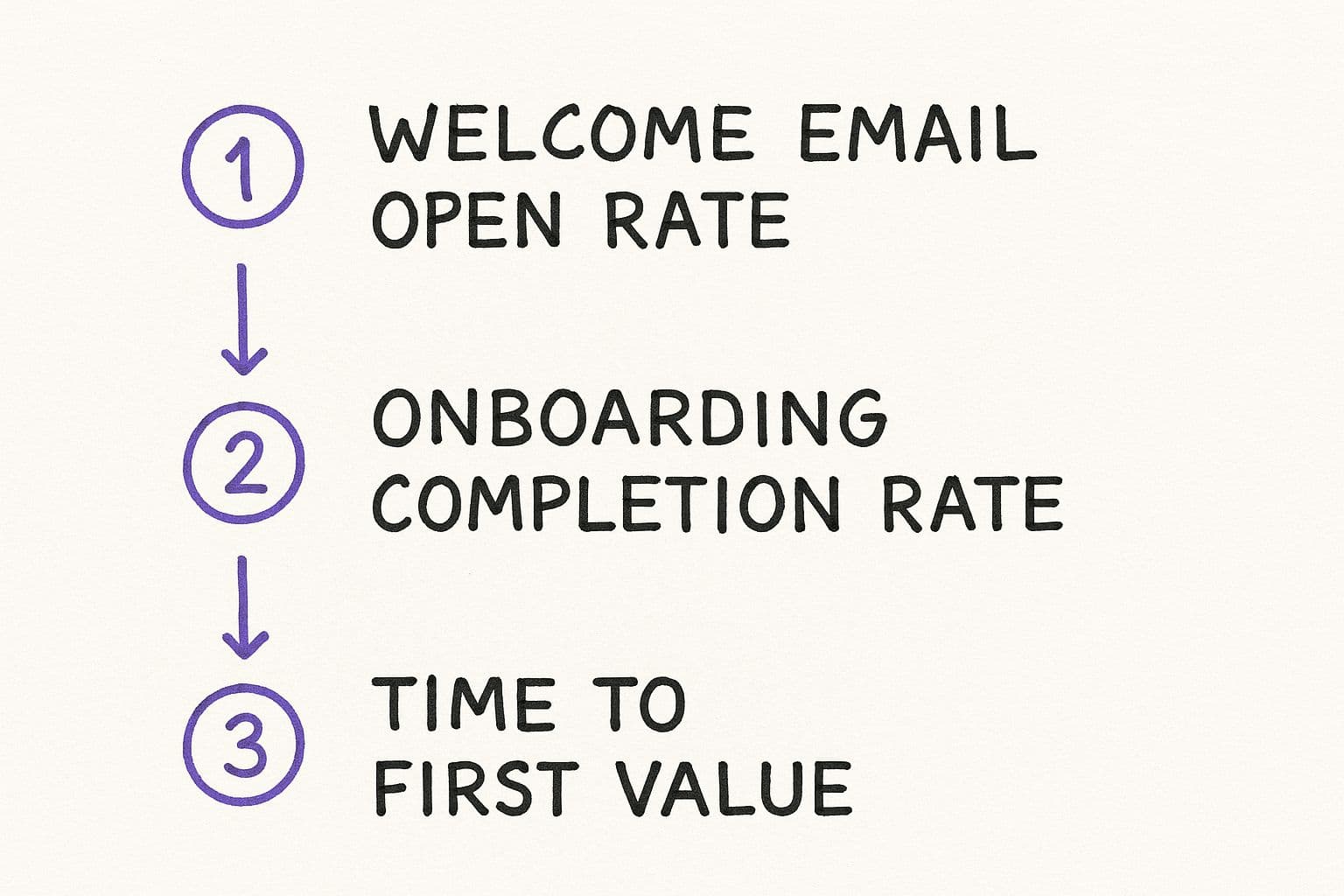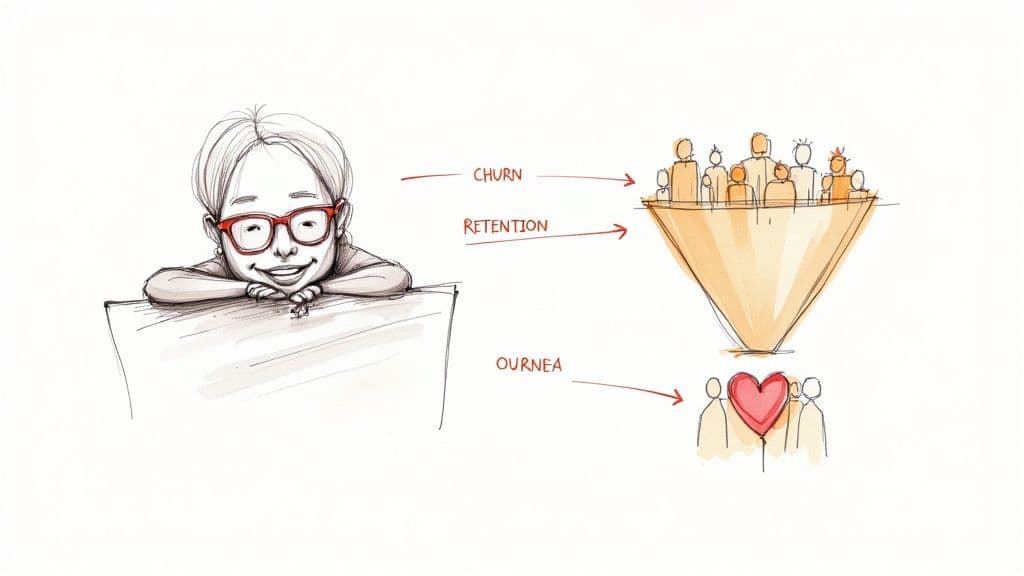Understanding the Real Psychology Behind Customer Departures
If you want to figure out how to reduce churn rate, you have to get real about why subscribers actually pack their bags. It’s almost never a single, dramatic event. Instead, it’s more like a slow fade—a collection of minor frustrations and quiet disappointments that chip away at their loyalty over time. Think of it like a friendship fizzling out; the final goodbye is usually just the endpoint of a long period of subtle drift.

3b06b74a-86c4-43bc-bf62-9da9ed85a5e1.jpg
Customers on their way out often give off clues. They might start using your service less, ignore new features, or go silent in a community where they were once a regular voice. These behavioural signals are where the real insights are hiding. An exit survey might say "price" was the reason for leaving, but that’s often just the easiest box to tick. It’s a convenient excuse that masks a deeper problem.
Maybe they didn't feel they were getting enough value for the money, or a clumsy support chat left them feeling like just another number. The price isn't the disease; it's the symptom. The real work is digging into the emotional triggers behind their decision long before they even consider hitting ‘cancel’. This is why paying close attention to every step of the customer journey is so important.
Reading Between the Lines of Customer Behaviour
The smartest companies don't wait for complaints to pile up; they proactively spot at-risk customers by looking for patterns. For instance, a subscriber who was a daily presence in your Telegram community but hasn't posted in a month is a potential churn risk. A user who keeps visiting the help centre for the same issue without finding a solution is another. These aren't just data points; they're silent cries for help.
Your mission is to build a system that flags these behavioural shifts, giving you a chance to step in with a helpful, human touch. It could be as simple as, "Hey, we've missed seeing you in the group lately. Is everything alright?" This small gesture can transform a purely transactional relationship into a personal one.
The True Cost of a Bad Experience
Never underestimate the damage a single negative interaction can do. In the UK, startling data shows that nearly one in three customers will ditch a brand after just one bad experience. That statistic should be a wake-up call, highlighting that every single touchpoint matters—from the first welcome email to a routine support ticket.
Brands that get the customer experience (CX) right don't just reduce churn; they flourish. They generate 5.7 times more revenue than competitors who let CX slide. By focusing on creating consistently positive and helpful interactions, you’re not just saving one customer; you’re making a serious investment in your long-term growth. You can find out more about this connection by exploring detailed CX reports that focus on the UK market.
Creating Churn Prediction Systems That Beat Your Competition
Waiting for a cancellation email to land in your inbox is like waiting for a storm after the roof has already caved in—you’re far too late. The best way to lower your churn rate is to stop reacting and start predicting. This means building an early warning system that flags at-risk customers weeks or even months before they’ve considered leaving. A common mistake is relying on generic engagement scores, which often don't tell the full story. True predictive power comes from watching specific behavioural patterns that show waning interest or growing frustration.
For instance, a sudden drop in feature usage, an increase in support tickets for the same problem, or declining logins are classic red flags. By setting up automated monitoring, you can combine these different signals into a single, actionable customer health score. This isn't about spying on your members; it’s about being a more attentive partner. It allows you to trigger personalised, helpful interventions before a minor annoyance becomes a deal-breaker. A customer who repeatedly visits your pricing page might not be ready to leave, but they could be questioning the value they receive. A gentle, automated email highlighting a new feature they haven’t used yet can re-engage them at the perfect moment.
To get this right, you need to know which metrics actually matter and when to act. The table below breaks down the key indicators we track to build a customer health score, moving from 'healthy' to 'critical'.
| Metric | Healthy Range | At-Risk Threshold | Critical Action Required |
|---|---|---|---|
| Login Frequency | >4 times/week | 1-2 times/week | No logins in the last 14 days |
| Feature Adoption | Uses >75% of core features | Uses 25-50% of core features | Only uses 1-2 basic features after 30 days |
| Support Tickets | 0-1 per month | 2-3 per month (unresolved) | >4 tickets for the same issue without resolution |
| Onboarding Status | 100% complete in 24h | 50-75% complete after 7 days | <50% complete after 14 days, key integrations missing |
| Pricing Page Visits | 0-1 per quarter | 2-3 visits in 30 days | >4 visits in a week, especially near renewal date |
This table isn't just a list of metrics; it's a blueprint for proactive intervention. When a customer slips into the "At-Risk" column, an automated, low-touch interaction is often enough to steer them back. But once they hit "Critical," it’s time for a high-touch, personal outreach to understand and resolve their issues before it's too late.
Key Onboarding Metrics That Predict Future Churn
The first few weeks of a customer's journey are incredibly telling. This is where you either secure their loyalty or plant the seeds of doubt. Instead of just hoping for the best, you should be tracking these critical early-stage metrics to predict long-term retention.
This infographic shows the crucial first steps that directly influence whether a new subscriber will stick around for the long haul.

ee200a1a-7f0b-48a5-acb5-3b6b0ce6d872.jpg
The flow is clear: a poor start in any of these areas creates a domino effect that often leads directly to churn.
Here’s a breakdown of what to watch for:
- Welcome Email Engagement: A low open rate on your first email is a huge warning sign. If they don’t even bother to open your welcome message, their initial commitment is already on shaky ground.
- Onboarding Completion Rate: Did they actually finish the setup guide? Did they connect their Stripe account? An incomplete onboarding process means they haven’t unlocked your product’s core value, making them a high churn risk. One study found that 67% of customer churn is preventable if the initial issue is resolved during the first interaction.
- Time to First Value (TTFV): How quickly does a new user experience that "aha!" moment? The longer it takes for them to see a real benefit, the less likely they are to stay. For Telegram creators using MyMembers, this could be the moment they receive their first payment. For anyone managing a subscription service, understanding the various business models can help you optimise your own. You can explore more options in our guide on subscription business model examples to see what might work for you.
Designing Retention Offers That Feel Like Genuine Solutions
Let's be honest, a generic "Please don't go!" email with a random 10% discount is more likely to annoy someone than win them back. It screams that you haven't been paying attention to their specific problems or why they're leaving in the first place. If you really want to figure out how to reduce churn rate, you have to stop sending one-size-fits-all pleas.

831aacea-adbb-40e7-9cf9-5c67a0eb0902.jpg
Instead, your offers should feel like genuine solutions to their problems. This starts by digging into why a customer is leaving, not just who they are.
Instead of just throwing discounts at the wall to see what sticks, group your at-risk users by their behaviour. Did their activity nosedive after you changed a feature? Did they keep hitting up the help centre about the same issue? Each of these situations needs a different, more thoughtful response. When you connect your retention offers directly to the pain points you've found, you're not begging; you're starting a helpful conversation.
Tailoring Offers to Behavioural Segments
Crafting offers that actually work means you need to understand what's driving your customer's decision to leave. For example, if you see a group of users are all struggling with a particular complex feature, a discount is useless. What they really need is help. Offering a free, one-on-one "success call" to walk them through it is a much better solution.
Here are a few scenarios I've seen and the targeted offers that actually get results:
- The Price-Sensitive User: You see someone repeatedly visiting your pricing page or checking out competitor websites. A temporary discount or an offer to switch to a lower-priced plan can work wonders here. You're not just cutting the price; you're helping them manage their budget while still getting value from your service.
- The Under-Utilising User: Your analytics show they’re only scratching the surface, using just the basic features. Offer them an extended trial of your premium tools. This isn’t just a freebie; it’s an invitation to discover more value, tackling their potential lack of engagement head-on.
- The Frustrated User: This customer has a history of support tickets and seems genuinely stuck. An offer of premium, priority support for a month can be a powerful move. It shows you’ve recognised their frustration and are serious about making their experience better.
This targeted strategy is vital no matter what industry you're in. Look at the UK telecommunications sector, for instance. Companies there invest heavily in personalised offers and loyalty schemes to tackle specific reasons for churn, like service issues or tempting competitor deals, rather than just slashing prices across the board. You can find out more about these telecom retention strategies and how effective they are. It's this kind of strategic thinking that turns a likely cancellation into a loyal customer.
Implementing Smart Technology Without Losing the Human Touch

embed
Finding the sweet spot between automation and genuine care is where the best retention strategies live. Technology should be your sidekick, helping you deliver personalised experiences at scale without making your members feel like they're just another number in a machine. The idea isn't to replace the human element, but to supercharge it. You're freed up to have meaningful conversations while smart systems take care of the repetitive tasks. This is central to figuring out how to reduce churn rate for good.
The trick is to use tech that builds the relationship, not makes it more complicated. Think of automated email sequences that trigger based on what a member does—like sending a quick tip to a new subscriber who hasn't tried out a key feature yet. It could also be a simple, automated "Hey, how's it going?" message to someone who's been inactive for a week. These small, automated touchpoints show you’re paying attention, all without you having to manually track everything.
Choosing the Right Tools for the Job
Your tech stack should be all about ROI, not just fancy features. While platforms like Salesforce CRM solutions are brilliant for handling massive amounts of customer data, for most creators, simpler tools often deliver more immediate value. The right platform automates your retention workflows, helps you track satisfaction, and measures what's working without a massive learning curve or price tag.
Take a lesson from other industries. In the UK, the telecommunications sector has been pouring money into digital channels and personalised marketing tools to fight rising churn, which hit a staggering 31% in 2021. This move shows a clear shift towards using technology for frequent, meaningful engagement, not just blasting out generic updates. You can find out more about these industry churn benchmarks and the strategies they're using to tackle them.
For creators, especially those on platforms like Telegram, the right tool can change the game completely. For example, MyMembers provides analytics dashboards that give you a crystal-clear picture of your revenue and member activity in real-time.
This screenshot shows how a creator can instantly see their monthly earnings and active subscriber count in one clean interface. Having this data at your fingertips means you can spot trends early. If you see a dip in renewals, you can jump in with a targeted retention campaign before it snowballs into a bigger issue. It’s all about using technology to get insights that lead to smarter, more personal interactions.
Converting Support Interactions Into Retention Opportunities
Every support ticket is a fork in the road. One path leads to a quick fix and a forgotten conversation. The other leads to a stronger relationship and a member who feels genuinely heard. If you really want to lower your churn rate, you need to train your support team to guide every interaction down that second path. This isn't about just closing tickets; it's about actively building loyalty.

808f9e09-574c-422f-9332-06181c35b6d4.jpg
Think of your support department not as a cost centre, but as a goldmine of retention opportunities. The conversations happening there tell you exactly what causes friction for your members. By equipping your team to spot the difference between a simple question and a sign of deeper frustration, you can tackle underlying problems before they grow into cancellations.
Imagine a member asks how to cancel their plan. A reactive response is to simply give them the instructions. A proactive one sounds more like this: "I can certainly help with that, but I'm curious, is there anything we could do better for you?" That simple question changes the entire dynamic of the conversation.
Proactive Support And Service Recovery
Turning support into a retention engine means going beyond just reacting to problems. It's about proactive outreach and having a solid plan for service recovery when things inevitably go wrong. Research shows that a staggering 67% of customer churn is preventable if the issue is sorted out during the first conversation. This shows just how crucial it is to get that first interaction right.
Here are a few practical strategies to put this into action:
- Proactive Check-ins: If your analytics show a member is struggling with a feature, don't wait for them to complain. Send a friendly message with a helpful tip or a link to a tutorial.
- Follow-up Systems: After you've solved an issue, schedule a quick follow-up message a week later to make sure everything is still running smoothly. This small act shows you care beyond just the initial problem.
- Service Recovery Frameworks: When a major problem happens, empower your team to offer a sincere apology and a small gesture of goodwill, like a free month of membership. This can turn a frustrated customer into one of your biggest advocates.
The table below shows how different approaches to support can have a direct impact on whether a customer decides to stick around.
| Response Time | Resolution Method | Customer Satisfaction | Retention Rate |
|---|---|---|---|
| < 1 Hour | Proactive follow-up & goodwill gesture | 95% | 92% |
| 1-6 Hours | First-contact resolution | 80% | 75% |
| 24 Hours | Standard ticket resolution, no follow-up | 65% | 58% |
| > 48 Hours | Multiple interactions, escalated issue | 40% | 33% |
| No Response/Bot Only | Automated response, no human interaction | 15% | 10% |
As you can see, speed and the method of resolution aren't just about good service; they are directly tied to your bottom line. A proactive approach with a human touch almost guarantees a member will stay.
To really make customer support a powerhouse for retention, think about ways to respond to questions efficiently and engage with members before they even have a problem. You can learn how to automate customer support effectively to handle simple queries, freeing up your team for more complex issues. A blend of smart automation and a personal touch is the key. These support-driven efforts are a vital part of a bigger plan; for more ideas on expanding your member base, have a look at our guide on membership growth strategies.
Tracking Success With Metrics That Actually Matter
Putting new retention tactics into play without measuring their impact is a bit like driving blindfolded—you’re definitely moving, but who knows if you’re heading towards a cliff? To figure out how to genuinely lower your churn rate, you need to look past the surface-level numbers that make you feel good but don’t predict long-term loyalty. Sure, a drop in cancellations this month is great, but is it a sign of lasting happiness or just a temporary blip?
The trick is to focus on metrics that forecast real customer value, not just short-term wins. This means swapping vanity metrics for actionable indicators that tell you the real story about your customer relationships. For example, instead of just staring at your overall monthly churn rate, start breaking it down by customer cohort. This can show you if the onboarding changes you made last month are actually improving retention for new subscribers compared to those who joined six months ago.
From Vanity Metrics to Valuable Insights
To build a retention strategy that actually gets better over time, you need a reporting system that helps you make smart decisions, not one that gives you data overload. It's incredibly easy to drown in a sea of charts and dashboards. The real goal is to pinpoint the handful of metrics that truly matter. The most successful companies I've seen don’t track everything; they refine their focus on a few powerful indicators.
- Customer Lifetime Value (LTV): This is the king of all metrics for a healthy customer base. When your LTV starts to climb, it’s a clear signal your retention efforts are paying off. It proves you’re not just keeping subscribers, but you're keeping the right ones who find lasting value in your offer.
- Net Promoter Score (NPS) and CSAT: Satisfaction surveys are more than just feedback forms; they're crystal balls. A sliding NPS score is an early warning that churn is brewing on the horizon, giving you a precious window to act before customers start leaving in droves.
- Revenue Churn vs. Customer Churn: It's so important to know the difference between losing customers (often called logo churn) and losing revenue. Losing ten small accounts might be annoying, but losing one major enterprise client could be devastating. Tracking revenue churn helps you focus your energy on your most valuable customer segments.
Calculating the Real ROI of Your Efforts
Every retention tactic you use is an investment, whether it’s the time you spend on a success call or the cost of a promotional discount. You absolutely have to know if it's paying off. A simple way to do this is by testing different approaches on small, specific groups. For instance, offer one at-risk cohort a one-month discount, and give another a free training session. Then, just watch which group has a better retention rate over the next three months. This kind of A/B testing gives you solid data on what actually works for your audience.
This is especially important when you're setting your prices. A well-thought-out pricing structure can have a massive impact on retention. To get your own strategy right, it helps to see what others are doing successfully. You can find some great inspiration by looking at these effective subscription pricing examples. At the end of the day, measuring success is all about connecting your actions to real results and constantly tweaking your approach based on what the data is telling you.
Your Complete Retention Implementation Roadmap
Turning insights into action is where the real work of slashing churn begins. It’s time to move past the theory and build a practical roadmap that actually fits your resources and goals. This isn't about drafting some overwhelming, multi-year plan. Instead, we'll focus on a series of achievable milestones that give you both quick wins and sustainable, long-term improvements.
The secret is to prioritise the actions that will have the biggest impact on your business right now. Let's break down your strategy into manageable phases, each with a clear objective. This makes the whole thing less intimidating and helps you demonstrate progress to anyone watching.
The First 30 Days: Foundation and Quick Wins
This first month is all about laying the groundwork and grabbing the low-hanging fruit. Your focus should be on immediate, high-impact actions that don't need a huge team or budget.
Your main goal? Pinpoint the biggest reasons customers are leaving and launch a simple, proactive campaign to stop it.
Here’s what you can do:
- Conduct 5-10 exit interviews: Don't just rely on survey data. Personally reach out to customers who have recently cancelled. A quick email or call asking open-ended questions will reveal the real "why" behind their decision. You'd be surprised what people will tell you if you just ask.
- Set up basic health monitoring: You don’t need a complex system yet. Use your existing analytics to track one or two key risk signals. A sudden drop in logins or seeing a new user fail to complete onboarding are classic red flags.
- Launch a proactive support check-in: Create a simple, automated email for users who haven't logged in for 14 days. A friendly, "Hey, just checking in to see if you need any help getting started?" can work wonders and feels personal.
- Review your involuntary churn: Take a hard look at your payment failure rates. A shocking amount of churn happens simply because a credit card expired. Setting up dunning emails (payment reminders) is one of the fastest, easiest wins you can get.
The Next 60 Days: Optimisation and Segmentation
With a solid foundation in place, the next couple of months are for refining your approach and getting more specific. You’ll start using the data you've gathered to create more personalised interventions that hit the mark.
The objective here is to segment your at-risk users and test different retention offers to see what sticks.
Here are your action items:
- Segment your at-risk list: Don't treat all at-risk users the same. Group them based on their behaviour. For instance, create one segment for users with low activity and another for those who frequently contact support.
- Test two different offers: For your low-usage segment, try offering a temporary discount to remind them of the value. For the high-support segment, maybe offer a free one-on-one success call to resolve their issues. Measure which approach works better. For a deeper look at effective methods, you can explore these 7 proven strategies to reduce churn rate.
- Implement a feedback survey: Use a simple Net Promoter Score (NPS) or Customer Satisfaction (CSAT) survey to start collecting ongoing feedback. This gives you a continuous pulse on customer happiness.
Building a retention roadmap is a continuous process of learning and adapting. Start small, measure everything, and build momentum from there.
With the right tools, this process becomes much smoother. MyMembers provides the real-time analytics you need to spot at-risk subscribers and the automation to act on those insights instantly. Start your free trial today and turn your churn problem into a retention success story.
